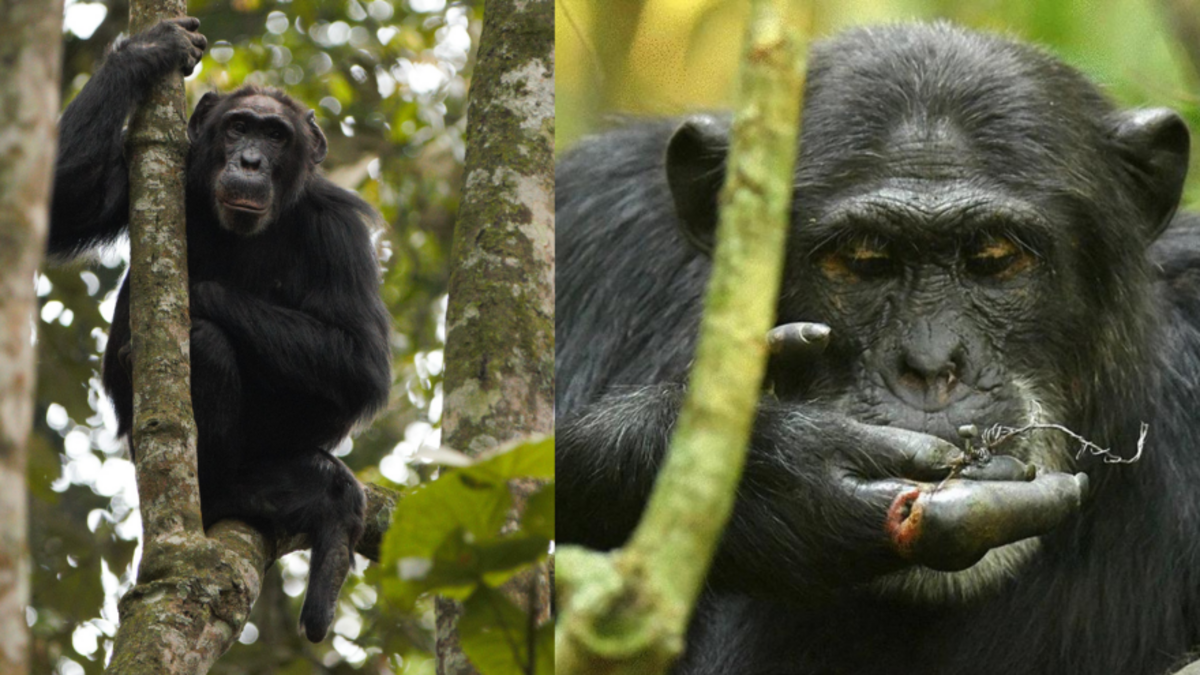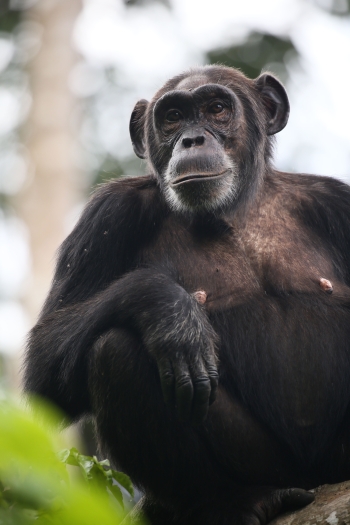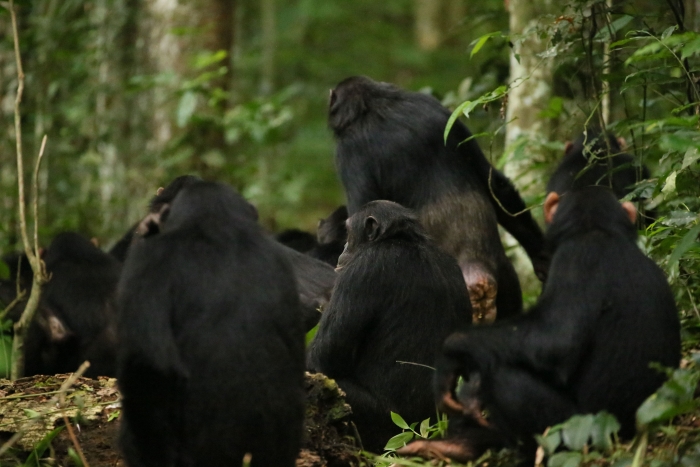ASU primatology, snare removal program supports chimpanzee conservation

Chimpanzees caught in snares lose and injure their fingers, toes, hands and feet. Lita (left), an adult female chimpanzee, lost her foot. Photo by Kevin Langergraber. Peterson (right), an adult male, was the only chimpanzee snared at Ngogo after ASU primatologist Kevin Langergraber and his team started the snare removal program in 2011. With the help of the Uganda Wildlife Authority, they successfully removed his wire snare. Photo by Kevin Lee
Snares are a common tool often used by hunters in Uganda looking to catch small, wild game meat. Unfortunately, the snares are also capable of catching wild chimpanzees, resulting in injured fingers, toes, hands, feet — and sometimes complete amputation.
Kevin Langergraber, an associate professor at Arizona State University's School of Human Evolution and Social Change, has been studying the Ngogo community of chimpanzees in Kibale National Park in Uganda for over two decades.
A research scientist at the Institute of Human Origins at ASU, Langergraber serves as director of the Ngogo Chimpanzee Project, where he and a team of scientists study, research and work to protect the primates through conservation efforts.
After witnessing and helping chimpanzees who were getting injured in snares, Langergraber and his team decided to implement a snare removal program in 2011. Their report, published last month in the journal Primates, is the first to statistically show how snare removal helps conservation efforts.
“We compared the number of times chimpanzees were snared during the 12.75 years after the start of this project with the number of times individuals were snared during the previous 14 years," Langergraber said. “Only one chimpanzee was snared after we began removing snares, compared with 12 individuals caught during the period before.”
This showed a 79% reduction in the number of victims after implementing the snare removal program. In their report, “Removing snares is an effective conservation intervention: a case study involving chimpanzees,” the scientists explained that snared chimpanzees have more intestinal parasites, are not able to run fast — putting them in danger of being attacked by other chimpanzees — and have decreased locomotor skills, making it difficult to safely be in the canopy of the forest.
Langergraber helped free a chimpanzee from a snare while he was following the Ngogo chimps outside their normal trail systems. The chimpanzees make journeys outside their normal areas to hunt for monkeys and even other chimpanzees from outside groups, he explained. These farther-out areas are where they are most likely to encounter snares.
“There was a commotion and screaming at the front of our party that I could not see,” he said. “It turned out that an old female, Tosca, had her hand caught in a metal wire snare at this log.
“The rest of the chimps crowded around her, with some reassuring her. But they did not try to help her get out of the snare. After she screamed for a while, I decided to try and free her. Luckily, there was a dense bush to sort of keep us separated. I just had a tiny pocket knife with me, so all that I could do was to try and cut the tree that the wire was attached to, so that although she would still have the wire wrapped around her finger, she at least would not be trapped there. She was freed and the wire eventually fell off, but not without some severe damage to her fingers.”
Since the start of the snare removal program, there are now eight two-person snare removal teams that patrol Kibale National Park in cooperation with the Uganda Wildlife Authority.
Langergraber encourages people who want to learn more about chimpanzees and conservation in Ngogo to watch "Chimp Empire." The four-part Netflix series was launched in 2023 and gives a never-before-seen account of the chimpanzees scientists and Langergraber study.
More Environment and sustainability

ASU celebrates World Ocean Day by honoring BIOS’ 120 years of marine research
The ASU Bermuda Institute of Ocean Sciences (ASU BIOS), one of the world’s longest-running research and educational institutions, held a symposium and community reception in Bermuda using World Ocean…

Tackling Phoenix’s ozone problem with natural emission research
Phoenix has an ozone problem. In the summer, residents may see it as a brown haze that hangs over the Valley. Urban emissions with high levels of sunlight create ozone that has made the air over…

The hidden cost of the American food system
Editor’s note: This is the third story in a series exploring how ASU tackles complex problems to help transform entire systems for the better. Read the first story, about the role of the university…

